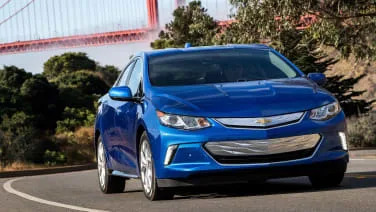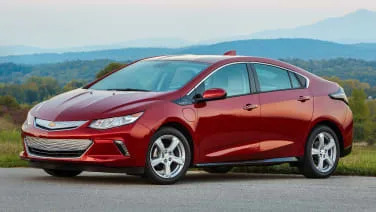2018 Chevrolet Volt
The Chevrolet Volt is a plug-in hybrid compact sedan with striking looks that are sleek and wedge-like. It offers the best of both worlds, able to run on electric power for 53 around-town miles, then switch to gas power to reach the next charge or the end of the tank of fuel on a road trip. If you don't have a long commute you'll rarely spend any money on gas. Volt's quality and capability were vastly improved for its second generation, so much that New Car Test Drive named it the Best Commuter Car for 2016. It's now in the third reliable year of that generation. It didn't change much for 2017, as there were no bugs to work out, nor has it changed for 2018.
Volt uses two motor-generators to drive the front wheels. They get their power from a lithium-ion battery pack with a capacity of 18.4 kilowatt-hours. One thing different about the Volt from most other plug-in hybrids, is that even under full throttle, it doesn't switch to gas; this means that if you drive it hard under electric power, you won't be able to go 53 miles, because it will use up its charge at a faster pace. However, it isn't burning gas when you don't want it to.
One exception: the engine will switch to gas power when the outside temperature is below freezing. It does this to heat the cabin.
Alternatively, the Volt can go far on a tank of gasoline: 380 miles on its 8.9-gallon tank.
It takes nine to twelve hours to fully charge the Volt, using any household 120-volt outlet and the conveniently located charging cable in the car. Using the optional 240-volt Level 2 charging station, that time is cut to four and one-half hours.
Among plug-in hybrids, Volt's 53-mile range is topped only by the BMW i3 REx, with 73 miles. But the i3's tiny two-cylinder engine isn't powerful.
For all practical purposes, the Chevrolet Volt has no competitors among plug-in hybrid cars. However, if a commuter is fixed on electric power, but finds that 53 miles a day isn't quite enough, he or she might look at the Chevy Bolt, an all-electric subcompact whose range is a world-beating 200 miles.
Volt's internal combustion engine is a 1.5-liter four-cylinder making 101 horsepower, new for this generation. Combined with the motor-generators, the total horsepower is 149 (111 kilowatts), with an impressive 294-pound feet of torque, as much as some V8 pickup trucks. Volt can accelerate from zero to 60 miles per hour in eight seconds, quicker than a Prius; and that's an all-electric versus gas-powered drag race, because the Prius switches to gas power under full throttle while the Volt stays with electric.
Volt's combined EPA rating, using both electric and fuel power, is 42 miles per gallon; but that's almost meaningless because it's hypothetical and theoretical, based on some average person's combined city-highway driving. An owner who never leaves the city might get infinite miles per gallon; indeed, some …
Full Review
Full Review
Volt's quality and capability were vastly improved for its second generation, so much that New Car Test Drive named it the Best Commuter Car for 2016. It's now in the third reliable year of that generation. It didn't change much for 2017, as there were no bugs to work out, nor has it changed for 2018.
Volt uses two motor-generators to drive the front wheels. They get their power from a lithium-ion battery pack with a capacity of 18.4 kilowatt-hours. One thing different about the Volt from most other plug-in hybrids, is that even under full throttle, it doesn't switch to gas; this means that if you drive it hard under electric power, you won't be able to go 53 miles, because it will use up its charge at a faster pace. However, it isn't burning gas when you don't want it to.
One exception: the engine will switch to gas power when the outside temperature is below freezing. It does this to heat the cabin.
Alternatively, the Volt can go far on a tank of gasoline: 380 miles on its 8.9-gallon tank.
It takes nine to twelve hours to fully charge the Volt, using any household 120-volt outlet and the conveniently located charging cable in the car. Using the optional 240-volt Level 2 charging station, that time is cut to four and one-half hours.
Among plug-in hybrids, Volt's 53-mile range is topped only by the BMW i3 REx, with 73 miles. But the i3's tiny two-cylinder engine isn't powerful.
For all practical purposes, the Chevrolet Volt has no competitors among plug-in hybrid cars. However, if a commuter is fixed on electric power, but finds that 53 miles a day isn't quite enough, he or she might look at the Chevy Bolt, an all-electric subcompact whose range is a world-beating 200 miles.
Volt's internal combustion engine is a 1.5-liter four-cylinder making 101 horsepower, new for this generation. Combined with the motor-generators, the total horsepower is 149 (111 kilowatts), with an impressive 294-pound feet of torque, as much as some V8 pickup trucks. Volt can accelerate from zero to 60 miles per hour in eight seconds, quicker than a Prius; and that's an all-electric versus gas-powered drag race, because the Prius switches to gas power under full throttle while the Volt stays with electric.
Volt's combined EPA rating, using both electric and fuel power, is 42 miles per gallon; but that's almost meaningless because it's hypothetical and theoretical, based on some average person's combined city-highway driving. An owner who never leaves the city might get infinite miles per gallon; indeed, some …
Hide Full Review
Retail Price
| Engine | I-4 |
| MPG | |
| Seating | 5 Passengers |
| Transmission | 1-spd auto |
| Power | 101 @ 5600 rpm |
| Drivetrain | front-wheel |
| Curb Weight | 3,519 - 3,543 lbs |





